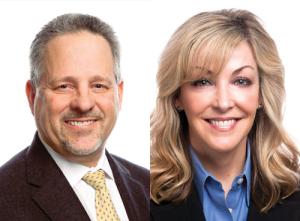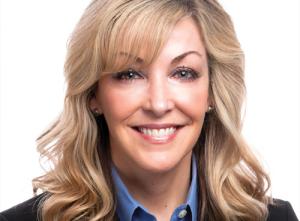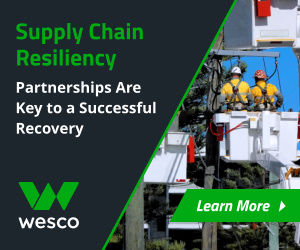NW Natural
David Anderson is the CEO, and Kim Heiting is SVP, at NW Natural.
How do today's natural gas utilities find the right balance, rigorously addressing ESG priorities while continuing to meet the needs of the communities they serve via gas utility service? In the conversations below, leaders from CenterPoint Energy, Eversource, NiSource, NW Natural, and Sempra Energy (both at San Diego Gas & Electric and at the parent) take on directly how they are managing that balance.

PUF's Steve Mitnick: Talk about your role at the utility and what's most important to you.
David Anderson: What's important is serving customers. We serve about 2.5 million people through seven hundred eighty thousand meters. We also have water customers in four states — Oregon, Washington, Idaho, and Texas.
The most important for me is to put a team together that will maintain the outstanding customer service and service ethic we've had for a long time. For well over a decade, NW Natural has ranked among the top five highest performing gas utilities in the J.D. Power's residential customer satisfaction survey.
Those rankings reflect not only service, but affordability, system safety and reliability. It's critical that folks like Kim and I run safe operations for our customers and employees.
 David Anderson: While natural gas is going to be an important fuel for many years to come, we know there are other things that can go through the pipe that are even cleaner.
David Anderson: While natural gas is going to be an important fuel for many years to come, we know there are other things that can go through the pipe that are even cleaner.
PUF: Why is ESG important to you and to your team at NW Natural?
David Anderson: ESG may be the latest moniker, but companies like ours have been focused on governance, social, and environmental initiatives, and the holistic philosophy it represents for a long time.
Strong governance and integrity are the backbone of any good company, and you have to come back to customers and understand their priorities. If you don't embrace your customers' and communities' priorities, you won't succeed.
For example, in the Pacific Northwest our customers expect an environmentally conscious utility. It's not only literally green, it's figuratively green here. One of our long-standing core values is environmental stewardship — and you see that come through in our carbon savings goal and our vision to be a carbon neutral energy provider in 2050.
 Kim Heiting: We had about 15% of our carbon savings goal achieved last year through this proprietary program that allows us to purchase natural gas from responsible producers.
Kim Heiting: We had about 15% of our carbon savings goal achieved last year through this proprietary program that allows us to purchase natural gas from responsible producers.
On the social side, NW Natural is focused on community service and creating a diverse, inclusive, and equitable workplace. The societal unrest we've experienced over the last year in our country and our communities has underscored that we — like other companies — need to redouble our efforts.
In the end, the most important thing about ESG is greater transparency and accountability. A lot of this was information we were already monitoring, reporting to agencies, and using for business decisions. Now we've put it in one place, for everyone to see. That makes our business everyone's business.
If we disclose our employee safety statistics, and they're not where we want them to be, what's the story behind that, and what are we doing to improve?
It's the same on the environmental side for our carbon footprint. What are we doing now and for the future to become a carbon neutral utility by 2050? ESG has brought a new lens to, and a higher level of transparency to, what's going on inside the organization.
PUF: How does the gas industry research and data roll into your thinking about your end point with carbon emissions?
David Anderson: When setting goals, it is important to understand your starting point. Natural gas is a highly valuable low-carbon fuel today. The United States has seen a substantial decline in emissions because of natural gas.
Since 2005, two-thirds of the electric power sector's emissions reductions were the result of that switch from coal to natural gas. And the direct use of gas for water heating, space heating, and cooking, is efficient.
For example, on the coldest winter day, we meet ninety percent of the energy needs for our residential space and water heat customers. Yet we're only about six percent of the state's greenhouse gas emissions when you look at our residential and commercial load.
Using the fuel directly in our distribution system — one of the tightest in the country — is the most efficient way. Customers appreciate that starting point, but we agree there's more to do.
While natural gas is going to be an important fuel for many years to come, we know there are other things that can go through the pipe that are even cleaner than natural gas.
Kim Heiting: In 2016, we did a comprehensive strategic planning process, looking at the role of our system within a climate policy context.
When we started on this journey to establish the role of our system in the low carbon future, we looked at three categories of carbon savings opportunities — our product, customers, and the transportation sector. In the first category, it's about reducing the carbon intensity of the product we deliver.
While the industry has seen significant reductions in methane emissions through best practices and new technology, the production sector remains the largest portion of emissions in the full value chain of gas.
In response, we've introduced a new supply purchasing criteria to reward the lowest emitting U.S. producers with our contracts. We had about fifteen percent of our carbon savings goal achieved last year through this proprietary program that allows us to purchase natural gas from responsible producers.
The next step is to evolve what's going through our pipe. We can continue to deliver the energy our customers need, while also helping communities and other sectors tackle their own waste issues. We're looking at renewable natural gas sourced from landfills, wastewater treatment plants, farms, and other feedstocks.
Beyond RNG, we're considering ways to incorporate hydrogen produced from excess wind and solar or hydro as a way of capturing renewable resources from the electric grid that would have otherwise been lost. We can store it, blend it up to a certain percentage into our gas supplies, or take that hydrogen and combine it with carbon dioxide that's a byproduct from a local industrial facility and create a low carbon synthetic natural gas.
We may even consider dedicated hydrogen systems to support those hard-to-decarbonize industrial sectors.
Our CEO had the foresight to send a small team to Europe, and we went to the U.K., Germany, France, and the Netherlands because we wanted to understand what they were doing in decarbonizing the gas networks.
It solidified that we were on the right path. Europe is five to ten years ahead of where the United States is in their thinking and in developing innovative projects that are driving more renewable natural gas and hydrogen onto the system.
We set up this fantastic cross-sectional team in our company — analytics, operations, and engineering. We set out to understand, how do we take these learnings and set a path forward?
This trip validated our voluntary carbon savings goal of thirty percent by 2035 and was a catalyst to evolve our vision to be a carbon neutral energy provider in 2050. The 2035 goal is unique because it encompasses our customers' emissions from their use, not just our company operations. Several years into the 2035 goal, we're on track.
We're exceeding where we thought we'd be, and we've had learnings that make us more optimistic about future reduction opportunities. When we established the goal, we didn't know the potential of renewable natural gas and hydrogen.
We have a lot more data and analytics now. We have the first of its kind renewable natural gas legislation in the country.
We've begun the procurement process on behalf of our customers to secure that supply. We have a dedicated renewables team. We've contracted about two percent of our supply, and we're pleased with this swift progress. To put it into context, wind and solar energy comprise about eleven percent of electric generation nationally.
PUF: How is the renewables message coming through?
Kim Heiting: Anytime we're thinking about business strategy, we start with customer research. We ground ourselves in, what do our customers think?
There are also advocacy groups and activist groups that we consider. We're familiar with what some of those groups want, but we start with our customers.
Over eighty percent of our customers want us to be pursuing renewable natural gas, to be working on solutions that balance affordability and our climate objectives.
We know through preference research that eight out of ten prospective home buyers in our service territory want natural gas. It's an important component of their home purchase decision, and they're willing to pay more for it.
We also have a lot of people in our service area who are concerned about climate change. We believe it's possible to balance those.
We have a tight system. We've got a great starting point. Let's squeeze those emissions down, but let's do it while maintaining choice and resiliency.
In our view, green molecules and green electrons working together is how we're going to get to carbon neutrality for our energy system as fast and affordably as possible, while maintaining customer choice.
David Anderson: You hear folks say, anything that's a carbon fuel needs to go away today. Unfortunately, not everyone is an expert or understands how the energy system works, so part of our messaging, and one of the reasons I agreed to be Chair of American Gas Association, was to help folks understand the strengths of the gas utility system and why we need both the gas and electric systems.
Facts are important. The natural gas system is a powerhouse. NW Natural delivers more energy than any other utility in Oregon in a year. We meet seventy-four percent of home heating needs in the areas we serve, and the natural gas system delivers nearly twice as much energy as the electric system during those peak winter weather conditions.
That's the power of the fuel. It's simple. If you wanted to electrify everything, it's going to take at least two additional electric companies in our service territory to handle our peak energy demand. In parts of the country like ours, these peaks occur in the coldest periods, and can last for days or even weeks.
Batteries have an important role to play, but don't offer long duration energy storage. When you look at the average cost of using gas versus electricity across the entire value chain, it's roughly ten dollars per MMBTU for gas, and for electricity, it's about forty. That means any end use appliance on the electric side needs to be four times as efficient.
There are places for electricity and the gas system. The old adage of not putting all your eggs in one basket applies here.
For example, each system fares differently during weather events. The American Gas Association has done a great job of studying the resiliency of the gas system. The gas system does well in hurricanes because it is underground. It does well in winter snowstorms or winter events too. If February 2021 taught us anything, it was the importance of redundancy and resiliency.
In February, the storm that hit the Pacific Northwest ultimately hit the Midwest and the rest of the country, and our country experienced devastating cold. In our service territory, we had ice that damaged trees and power lines causing power outages affecting more than four hundred thousand electric customers — some for upward of ten days.
Despite the heroics of electric companies, the weather didn't cooperate to get the power back on. But if you had natural gas, then you had gas cooking, gas fireplaces, and hot water. These customers had the ability to cook and keep themselves warm. It was the same in Texas.
If you combine February fourteenth and fifteenth of 2021, it was a record send out of natural gas for our nation. Thirty-eight percent of that gas came from underground storage. The LDCs performed very well and were a key component of resiliency for the energy system.
Redundancy and resiliency are important factors we can't forget as this transition takes place. The other factor is affordability.
We need a ton of renewables to reach our collective decarbonization goals. It's going to be difficult and expensive, so you better do it the most economical way, and with the most resilient systems. That's why we need both green molecules and green electrons working together.
PUF: Where do you think this is going within the next five years?
David Anderson: I will argue on the E — Environment — side, we're going to follow Europe. Europe is five to ten years ahead of us in this transition.
They've realized the gas system is important. You need to have as much renewable natural gas as possible. Hydrogen needs to happen going forward.
People will do the math and get to the logical answer, which is the answer that we came to as opposed to the emotional answer.
On the S, as a company, we're going to be better than we are today. Safety continues to be paramount for any utility company and it's also diversity, equity, and inclusion.
I'll give you an example on the safety side, where putting customers and employees first matters and can create a win in other areas as well. At NW Natural in the 1980s we worked proactively with our regulators to create a pipeline replacement program, and by 2015 we'd replaced all our cast iron and bare steel pipe.
Today we can inspect our pipelines with the most modern approach, catching anomalies quickly. That helps us have one of the tightest pipelines in the country. That's not only a great safety win, but also a great environmental benefit of keeping our product in our pipe.
On the diversity side, a quick example. We are one of the few utilities that has a construction entity in our company. The construction trade has traditionally been male-dominated. Three years ago, our head of HR and Chief Diversity Officer came to us and said, it doesn't have to be that way.
Why don't we do programs where we invite in people of color, females, and train them to be construction employees? It's been an outstanding success. In 2020 we increased the diversity of our recruiting pipeline for construction jobs to fifty-six percent, up from twenty-seven percent in 2019. That's what happens when you apply that DEI lens to business as usual.
On governance, the G side, if you're not already solid, you're in trouble. We'll continue to be an ethics-driven company and do what we need to do to make sure we keep the respect of our investors, customers, and employees.
In the end, all of this is for the customers. If this doesn't help the customer, it won't be successful.
ESG Naturally conversations:



